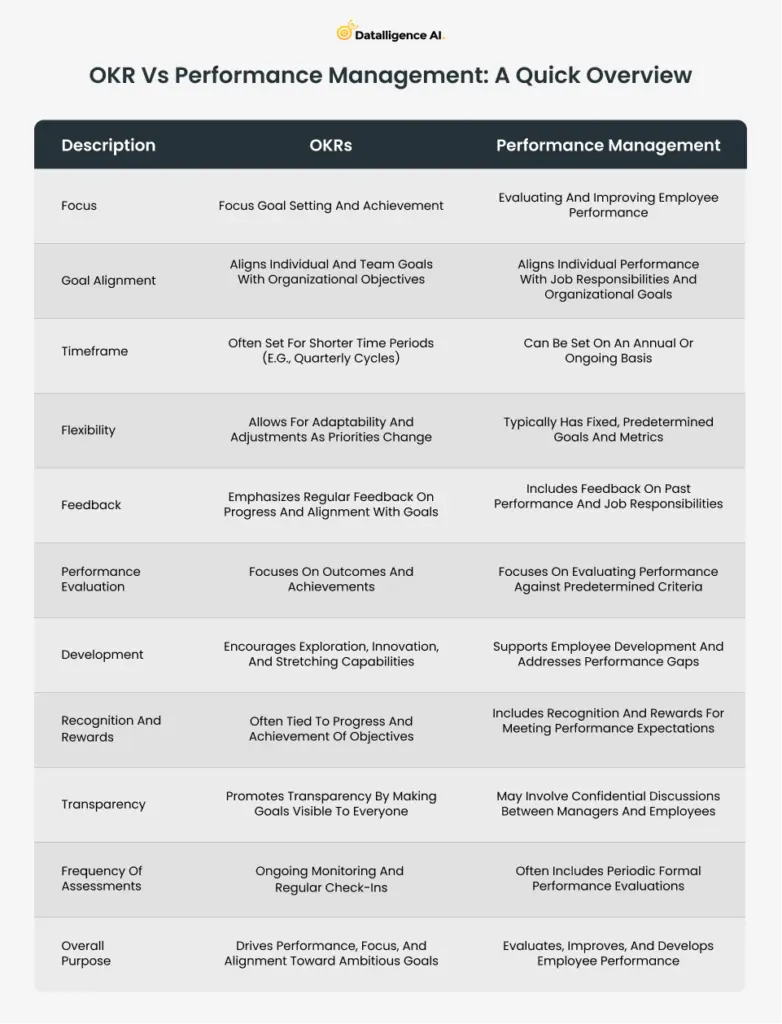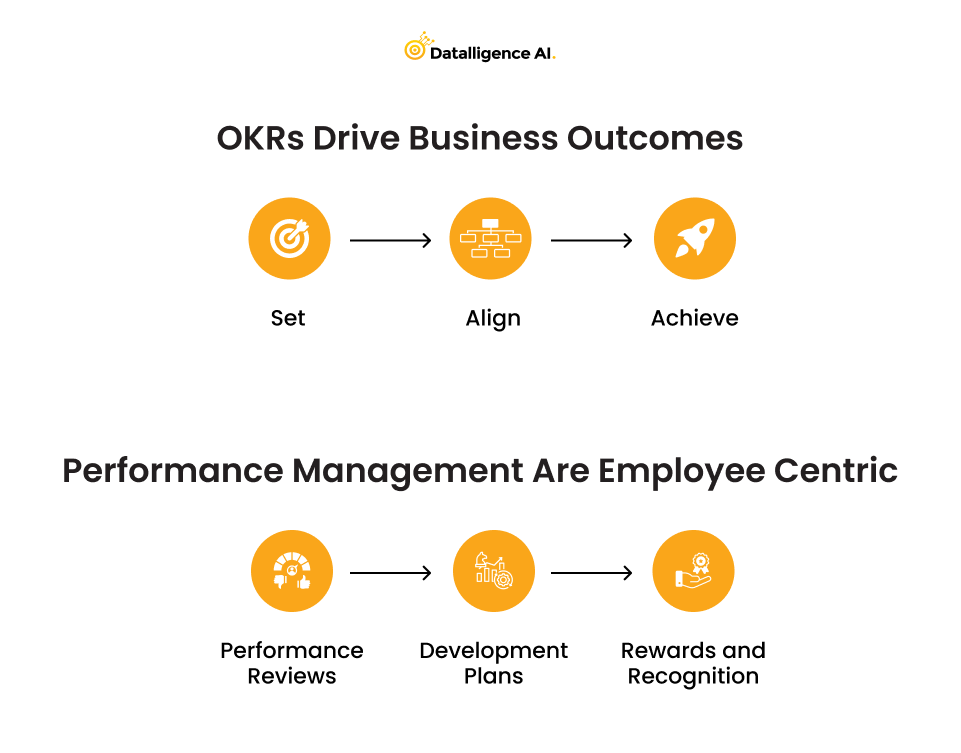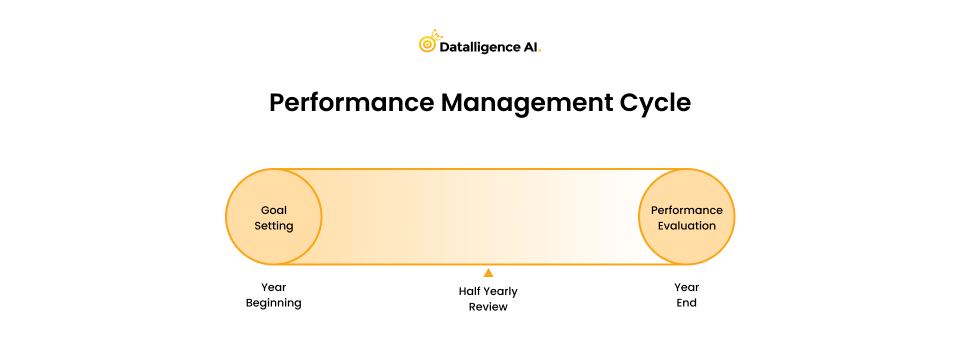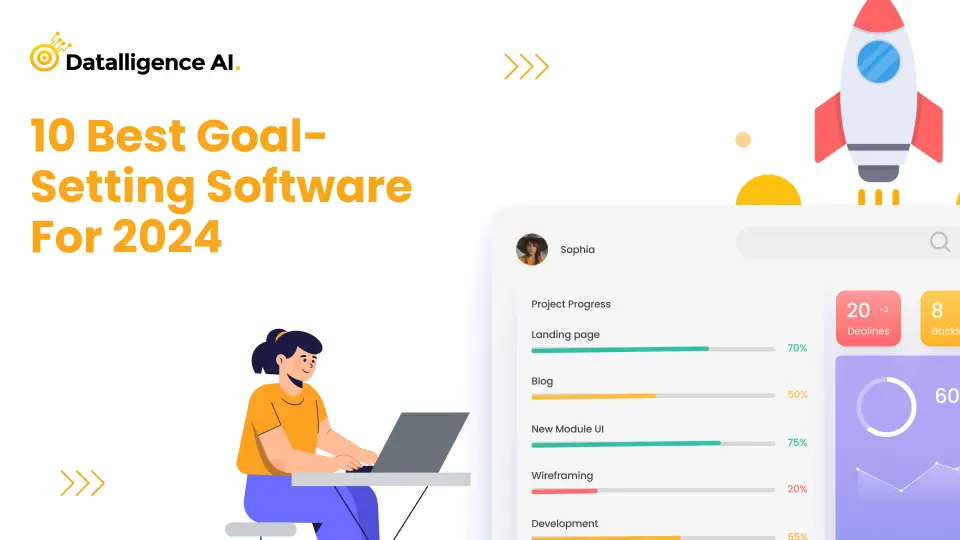It is obvious that OKRs are still an effective goal-setting tool today given how widely they are used in business today. This relevance dates back more than 40 years. In contrast, there is a declining popularity of Performance Management initiatives like Annual Performance Reviews in many companies.
As a result, many companies are turning to agile methodologies that provide flexibility, transparency, and continuous improvement.
In this blog post, we will explore the fundamental differences between OKR and traditional performance management systems, highlighting the unique features and benefits they bring to organizations. Before we delve into the core principles let us have a look at OKRs.
What is OKRs
OKRs, which stands for Objectives and Key Results, is a powerful goal-setting framework that helps individuals and organizations set and track their objectives clearly and measurably. It’s like having a roadmap with destinations (objectives) and milestones (key results) that guide you toward success. Objectives are ambitious, qualitative goals that define the desired outcome or direction. They should be challenging, inspiring, and aligned with the overall vision and strategy. Objectives are typically set for a specific time frame, such as a quarter or a year.
OKRs also provide focus, alignment, and transparency, enabling you to stretch beyond your comfort zone and achieve remarkable results.

The power of OKRs lies in their ability to provide focus, clarity, and alignment towards achieving meaningful goals. By setting ambitious objectives and defining measurable key results, OKRs help drive performance and create a culture of continuous improvement and accountability within organizations.
Key Features of Using OKRs:
- Clear and ambitious objectives aligned with organizational goals.
- Measurable key results that track progress and indicate success.
- Regular check-ins and updates to assess performance and make adjustments.
- Cascading of OKRs from top-level objectives to teams and individuals.
- Focus on transparency, accountability, and continuous improvement.
What is Performance Management System
Performance Management System is a comprehensive approach used by organizations to assess, manage, and improve the performance of individuals, teams, and the overall organization. It involves a set of processes, tools, and strategies designed to align individual and team goals with organizational objectives, provide ongoing feedback, evaluate performance, and identify areas for development and improvement.
The primary purpose of a Performance Management System is to establish a structured approach for evaluating employee performance, providing feedback, identifying areas for improvement, and recognizing and rewarding achievements.
Key components of a Performance Management System may include:
- Goal Setting
- Regular Performance Feedback
- Performance Appraisal
- Development Planning
- Performance Recognition and Rewards
- Performance Improvement
OKR vs Performance Management: A Quick Overview

Key Focus of OKRs and Performance Management Systems
OKRs concentrate on business outcomes, whereas performance management concentrates on an employee’s job performance.

OKRs focus on the business.
These broader business metrics serve as indicators of the effectiveness of the OKRs in driving positive outcomes for the organization. OKRs specify what must be accomplished by the organization as a whole, a department, a team, or an individual during a specific quarter. Furthermore, how do they track their success in achieving their goals? The general expectation is that as they accomplish those goals, the company will perform better overall in terms of client satisfaction, revenue, product quality, and supplier satisfaction.
Performance reviews focus on an employee and how their skills match up to their job requirements. The focus is on the employee, on improving their performance in their current role, on periodically understanding and realigning their career aspirations, and on assisting them with their career path through coaching, training, and sponsored higher education. The intention is to empower employees with the necessary resources and support to enhance their skills, achieve their career goals, and contribute effectively to the organization’s success.
OKR Cycle and Performance Cycle
OKRs have a quicker drumbeat. Performance reviews are typically conducted once a year and are generally very involved.


| Assessment Period for OKRs | Assessment Periods for Performance Management |
|---|---|
| Weekly, occasionally every two weeks | Once or twice a year |
For OKRs
How is the cycle initiated for OKRs?
- Corporate, departmental, and team OKRs are created at the start of each quarter.
- Individual OKRs are developed and synchronized with team, department, and corporate OKRs.
How is the cycle put to rest for OKRs?
- Teams, departments, and employees conduct at the end of the quarter to share their learnings on how they performed against their OKRs.
- Teams, departments, and employees evaluate where they are with each OKR to determine whether it makes sense to wrap up the OKR as is or to extend it to the following quarter based on business needs.
- New OKRs are added at each level once more in accordance with business needs.
For Performance Management
How is the cycle initiated for Performance Management?
- The assessment cycle is started by HR Department.
- Employees are given a set of competencies that are relevant to their job performance based on their grades, and they will be evaluated on these competencies.
How is the cycle put to rest for Performance Management?
- The assessment cycle is started by the HR Department.
- Employees conduct a 360-degree self-evaluation and receive confidential feedback from peers and superiors.
- The employee and manager then meet to discuss the results of the evaluation.
- Plans are made for the upcoming review period.
Why you shouldn’t mix OKRs and performance management
While OKRs and performance management systems have overlapping elements and goals, there are some reasons why it might be challenging or less effective to mix the two approaches:
Different time horizons
Performance management often operates on an annual cycle, with goals and targets set at the beginning of the year and evaluated at the end. In contrast, OKRs are typically set for shorter periods, such as quarterly cycles. This discrepancy in time horizons can lead to confusion and misalignment, as individuals may need to balance long-term performance objectives with shorter-term OKRs.
Fixed vs. Fluid Goals
Performance management often relies on predetermined and fixed targets, whereas OKRs emphasize setting ambitious and adaptable goals. When OKRs and performance metrics are intertwined, individuals may feel constrained by rigid performance criteria, limiting their ability to pursue innovative and game-changing objectives. This can hinder creativity, exploration, and risk-taking, which are key components of OKRs.
Accountability vs. Development
Performance management systems are often associated with evaluating and holding employees accountable for meeting predefined targets. In contrast, OKRs are intended to inspire and challenge individuals and teams to stretch their capabilities and drive innovation.
Combining the two approaches can create tension between accountability and the freedom to explore new ideas and take risks.
Complexity and Burden
Introducing both OKRs and performance management systems simultaneously can create a complex and burdensome process for employees and managers. It may lead to overlapping or redundant activities, such as tracking progress on OKRs and meeting the requirements of performance evaluations, which can be time-consuming and create confusion.
Feedback and Recognition
OKRs encourage regular feedback and recognition for progress made towards objectives. Performance management systems also incorporate feedback, but they often focus on past performance evaluations rather than ongoing progress.
The mix of the two approaches can create ambiguity regarding the frequency and purpose of feedback and recognition, potentially diminishing their effectiveness.
Conclusion
In conclusion, comparing the OKR framework with the traditional Performance Management System (PMS) reveals several key differences and advantages. While PMS focuses on evaluating employee performance through a set of predefined criteria, OKR emphasizes setting ambitious goals and tracking progress through measurable key results.
In terms of how Datalligene can help, adopting the OKR framework can positively impact an organization’s profitability. By aligning objectives and key results with the company’s financial goals, OKR provides a clear roadmap for driving revenue growth, cost optimization, and operational efficiency.
Talk to our Experts and Coaches and gain more insights or try Datalligence for free.











